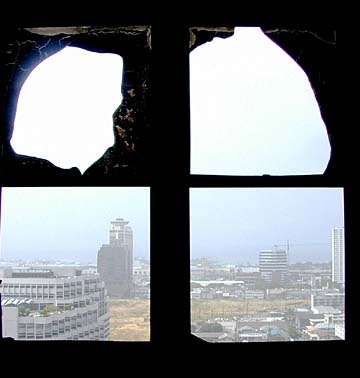Advertisement - Click to support our sponsors.


Firefighters: Lack
of sprinklers
hurt efforts
Record 23 fire companies involved
The blaze was a first for Honolulu
By Gordon Y.K. Pang
Star-BulletinHonolulu firefighters say the 16th story blaze at the Interstate Building Saturday would have not have turned into the city's worst high-rise fire if the building had a sprinkler system.
"In this case, I'm sure it would have made a big difference," said Battalion Chief Kenneth Silva. "All studies have proven that sprinkler systems are the most effective way to put out fires."
The Fire Department has not decided if it will recommend a change in the city's building codes to require older buildings to have sprinklers, but the City Council may take up the issue.
"There's a need to review it (building codes requiring sprinklers) because that issue was last reviewed 20 years ago and a lot of things have changed," said Council Chairman Jon Yoshimura.
Carol Costa, spokeswoman for Mayor Jeremy Harris, said he is asking Fire Chief Attilio Leonardi for a recommendation on the issue before taking a position.
The cause of the fire is still under investigation. Damage is expected to be in the millions of dollars. Eleven firefighters were treated at local hospitals and one remained hospitalized yesterday.
Firefighter Aaron Akiona, who is credited with helping rescue the most seriously injured firefighter, said sprinklers "definitely" would have helped put out the fire sooner.
"The sprinkler systems work real well," Akiona said. "We probably would have needed two, three or four engines and not 24."
Commercial structures at least 75 feet high built after 1978 are required to have a sprinkler system, Silva said. But the Interstate Building was constructed in 1974.
In 1983, the Council passed a bill requiring high-rise hotels to be retrofitted with sprinkler systems. Commercial and residential high-rise buildings were excluded from the new code requirement.
In 1992, the Council approved a bill requiring all existing high-rise residential buildings to install smoke detectors. But that did not apply to commercial or hotel buildings.
Interstate building manager Calvin Oki said the association of building owners considered putting in a sprinkler system after a fire in 1998, but the cost was estimated at $1 million and decision was made not to install it.
"You need pumps to get the water up there, and then each room has to be individually pumped," Oki said. "So we're talking a big job."
Oki said putting in sprinklers now still would be secondary to that of reopening the building.
Jane Sugimura, executive director of the Hawaii Council of Associations of Condominium Owners, said cost factors are a major concern for commercial and residential building owners.
"That's lot of money to pass on to tenants during time when they're just hanging in," Sugimura said.
Councilman Andy Mirikitani, who heads the Public Safety Committee, agreed.
"A major concern is whether the costs will be too burdensome and whether tenants will be able to handle the costs that would be passed on to them."
But Councilman Steve Holmes said cost should be weighed against safety.
Blaze was a first
By Rod Ohira
for Honolulu; record
23 fire companies involved
Star-BulletinSaturday's 16th-floor fire at the Interstate Building presented the Honolulu Fire Department with its most serious high-rise challenge to date.
It was Honolulu's first "seven-alarm" fire, says Deputy Fire Chief John Clark.
"It was an extraordinary event," Clark said. "We've lost an apartment or business, before but never an entire floor until now."
Most structure fires are "two-alarm" incidents, said Clark.
Each alarm represents three fire companies, usually two engines and a ladder, so 21 companies or more than one-third of Honolulu's 60 total companies were involved in the Interstate Building firefight.
"Actually there were 23 companies," Clark said.
"We've had 20 or more companies at brush fires but it's very significant for Honolulu to have that many companies at a structure fire."
There are more than 1,000 high-rises in Honolulu and firefighters respond to high-rise fires regularly, Clark said.
"Most have fire-protection systems and together with quick response, we've been able to knock out fires quickly." he said.